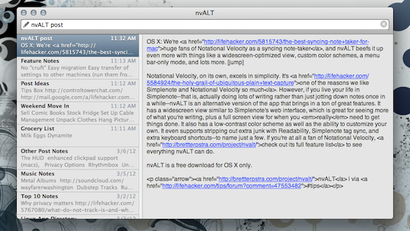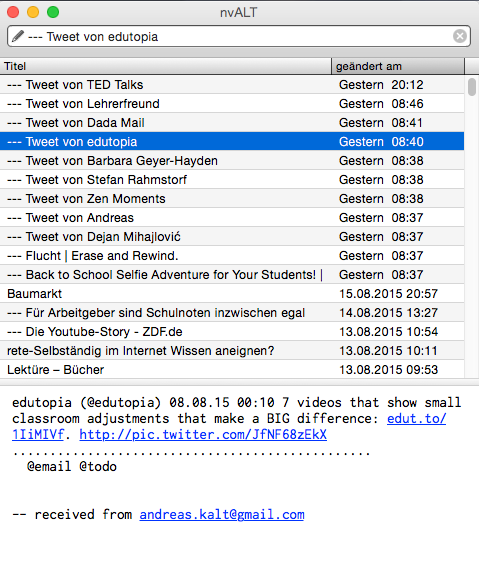

(PS Thought occurs – since I sometimes also do work in R, I can probably get that whole Rmd scene working with this as well.)
#Nvalt android mac#
(Set up on Mac is easy Windows not so easy, but here are instructions in my open notebook.) This folder is pushed to a github pages branch, and I’ve got myself a searchable open notebook wiki (with rss feed! So recipes from can be used to further mash things up).

With my session ended, I make sure to save all my cards, close Sublime, and go over to the terminal, and ‘pykwiki cache’ – et voila! The site is generated. (And I’m also using another script from Dan Sheffler which associates BibDesk cite keys with custom URLs to open up the pdfs I was reading in the first place, so my online notes will open my pdfs on this machine or any other one where I have that script installed.). Also, a notecard can be designated ‘private’ so it doesn’t show up in search, but is still findable if you know the direct url. …but can also include tags and other kinds of meta data that’d be useful to have. # Laurence, Space & Society in Roman Pompeii Title: Space Syntax in Pompeii - shortcomings I make sure to have a ‘data block’ for each note, which is ] again, above and below the metadata, with the body of the card below – at a minimum, it looks like this: [[ I do my readings, I make my notes, I generate my web of notecards. I designate Pykwiki’s ‘source’ folder as my Zettlekasten folder for Sublime text. Pykwiki *also* understands those ] as internal links! (caveat: don’t have any spaces in file names). But the files would lose that network of connections – remember, Sublime is interpreting my ] as an internal link. Now, I could just put my Zettlekasten in a github repo in the first place, and then push them online. md files and generate a site from them, which you can then put on your own server space (see a list of features here). Pykwiki is a static site generator, run from the command line, that will take a folder of. This is where Pykwiki comes into the picture. What is even better is being able to keep this structure, searchable, online in a way that could be forked. Dan also has a script for exporting annotations made on pdfs from Skim as markdown files ( my post on this), and the resulting md file can be chopped up quickly or integrated into the existing network of cards). So, with a bit of forethought and sensible naming conventions, I can quickly build up quite a network of cards. You can also crosslink as described above in nvAlt using the [[ and typing the first letters of the card you wish to crosslink to). Folks just getting started – start with nvAlt. Then, highlight the other options and hit the – button. Hit the + button under each one in turn, adding ‘md’. In ‘preferences, notes, storage’ there are two lists of file types. It’s a bit like Notational Velocity in that regard (and of course, you could use Notational Velocity if you wanted, though – I’d have to check – I don’t think you can save your notes as separate. If there is no file when I hit ] as the file name. When I type ] and I can ctrl click on that link to jump to the other file. In essence, Dan’s system is just a simple plugin for Sublime Text that designates a particular folder a ‘wiki’. In an earlier post I got the one-card-per-note ‘zettlekasten’ system that Dan Sheffler uses working on my machine (by the way, you will learn a *lot* if you spend some time reading Dan’s thoughts on the art of note taking). So what is this solution? Zettlekasten + Pykwiki. Mark Madsen’s explanation of how his open notebook works – and the logic he organizes it by – is similarly an inspiration: Īnd Ben Marwick’s work is pathbreaking (especially within archaeology): But first:Ĭaleb McDaniel’s eloquent argument for why one would want to do it is here: Tonight, I think I’ve hit a combination of tools that are sufficiently powerful and straightforward enough that I can integrate them into my undergraduate teaching. I’ve been looking for an open notebook solution for some time.


 0 kommentar(er)
0 kommentar(er)
